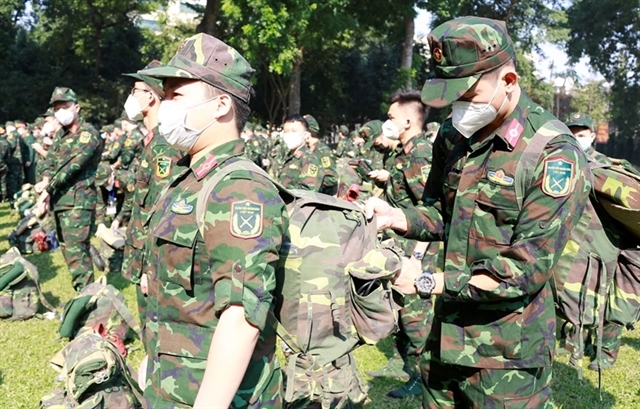 Society
Society

More volunteer medical workers have been sent to the southern region as COVID-19 cases and fatalities continue to increase.

|
| Volunteer military medical doctors, nurses and students prepare to depart for southern localities on COVID-19 missions on Saturday. —Photo chinhphu.vn |
HÀ NỘI — More volunteer medical workers have been sent to the southern region as COVID-19 cases and fatalities continue to increase.
The Ministry of Health on Monday asked hospitals at central level to assign staff to support southern localities’ efforts in the fight against COVID-19 at an online meeting held with some areas which have seen an increase in the number of new infections and deaths.
Minister of Health Nguyễn Thanh Long ordered the Department of Health Examination and Treatment Management to immediately review the mobilisation of human resources from central-level hospitals following the ministry’s Decision issued on November 30 to provide direct professional support for HCM City and 10 southern localities.
He asked hospitals to quickly send more medical forces to these localities and coordinate with local authorities in COVID-19 prevention and control.
In Cần Thơ City the number of COVID-19 patients increased to more than 30,000 and the city is at the level 3 of pandemic risk.
Under Resolution 128, the four levels of pandemic risk are: Level 1: low-risk (new normal) – labelled green; Level 2: medium-risk – labelled yellow; Level 3: high-risk – labelled orange and Level 4: very high-risk – labelled red.
Tây Ninh, An Giang and Sóc Trăng provinces have recorded nearly 50,000, 25,000 and 22,000 COVID-19 cases, respectively.
In response to the increase, these localities asked the Ministry of Health to send more medical workers to help them in treatment, allocate more vaccines, medicines, and ventilators.
Minister Long asked Hà Nội-based Bạch Mai, Việt Đức and E hospitals and the National Hospital of Endocrinology to send more staff to support An Giang, Bà Rịa-Vũng Tàu, Tây Ninh and Sóc Trăng provinces.
He said: “We will continue facing the increase in the number of COVID-19 cases because in many localities, many people still ignore recommendations from the health sector on pandemic prevention and control. When the new cases increase, the number of critical patients and deaths may also increase. Therefore, we need to strive to reduce the number of fatalities.”
He asked central-level hospitals to send medical experts to the southern localities to support treatment tasks while at the same time organising training to improve capacity for local medical workers.
He noted that localities that are at level 3 and 4 of pandemic risks must seriously implement COVID-19 prevention and control measures.
The ministry will continue allocating vaccines to meet the demand of these localities, according to Long.
He also instructed them to check the list of all elderly people and those with underlying diseases to make sure all of them were inoculated.
“Mobile vaccination sites should be organised or medical workers can go to houses of high-risk groups for vaccination to protect them from critical health conditions in case they are infected with SARs-CoV-2,” he said.
Regarding treatment, the Ministry of Health ordered the localities to classify patients and high-risk groups and apply the three-tier treatment model. The first tier is for patients without symptoms or with mild symptoms. The second tier, mostly at field hospitals and COVID-19 treatment hospitals, receives patients with medium symptoms and underlying health conditions. The third tier is for patients with critical health conditions.
Localities should immediately review the supply of oxygen for COVID-19 treatment facilities, he said, adding that the Ministry of Health could provide localities with ventilators but the localities themselves must prepare oxygen sources.
Medical workers on mission
The Military Medical University and three military hospitals on Saturday held a ceremony to bid farewell to 410 military officials, doctors, students and employees who volunteered to go to southern localities.
While there, they will take part in various activities, including providing treatment and care for COVID-19 patients at health facilities and work with local medical staff to guide citizens on COVID-19 symptoms and self-treatment measures at home.
At a reception held for the volunteer military medical workers on Saturday, Vice Chairwoman of Sóc Trăng Province’s People’s Committee Huỳnh Thị Diễm Ngọc, appreciated their support which she said would contribute more forces for the province to better control the pandemic and soon return to the new normal.
In August, when the fourth wave of COVID-19 was ravaging HCM City and southern localities, thousands of military doctors, nurses and students were sent to the south on COVID-19 missions.
Last week, Bạch Mai Hospital in Hà Nội sent a delegation of doctors and nurses from the departments of Critical Intensive Care, Emergency and Infectious Disease, who had experience in COVID-19 treatment and had supported many “hot” spots of COVID-19 previously, to help An Giang Province.
Meanwhile, a ceremony was held in Hải Phòng City on December 2 to send a group of doctors and nurses to Tây Ninh Province.
Director of the city’s Health Department Trần Anh Cường said the key task of the delegation this time was to directly treat critical COVID-19 patients in Tây Ninh and other missions assigned by local authorities. —VNS




